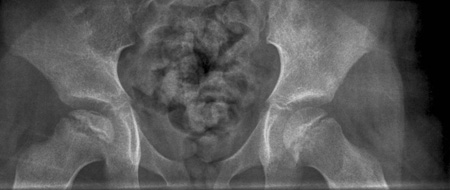Summary
Definition
History and exam
Key diagnostic factors
- presence of risk factors
- limp
- limited range of motion at the hip joint
Other diagnostic factors
- short stature
- muscle wasting
- hyperactivity
- Trendelenburg's sign
- synovitis
- knee pain
- thigh pain
- groin/buttock pain
- asymmetric limb length
- minor trauma
Risk factors
- male sex
- age 4 to 8 years
- low socio-economic background
- hyper-coagulable states
- urban population
- race and northern latitude
- transient hip synovitis
- hip joint effusion
- passive smoking
- skeletal dysplasias
- congenital anomalies
- trisomy 21
- behaviour disorders
- endocrinopathy
Diagnostic investigations
Investigations to consider
- FBC
- serum erythrocyte sedimentation rate
- serum C-reactive protein
- bone scintigraphy
- MRI of hips
Treatment algorithm
Contributors
Authors
Andrew Wainwright, FRCS (Tr & Orth) Med
Consultant Orthopaedic Surgeon
Nuffield Orthopaedic Centre
Oxford
UK
Disclosures
AW declares that he has no competing interests.
Dominique Knight, BSc, MBBS, FRCS
Consultant Paediatric Orthopaedic Surgeon
Bristol Royal Children’s Hospital
Bristol
UK
Disclosures
DK declares that she has no competing interests.
Acknowledgements
Dr Andrew Wainwright and Dr Dominique Knight would like to acknowledge Dr Jwalant S. Mehta and Dr Sandeep Hemmadi, who wrote the original topic and whose work is largely reflected in the current version. JSM and SH declared that they had no competing interests.
Peer reviewers
Phillip Thomas, FRCS (Orth)
Consultant Orthopaedic and Paediatric Orthopaedic Surgeon
Llandough Hospital
Vale of Glamorgan
UK
Disclosures
PT declares that he has no competing interests.
Young-Jo Kim, MD, PhD
Associate Professor of Orthopaedic Surgery
Children's Hospital
Boston
MA
Disclosures
Not declared.
Use of this content is subject to our disclaimer
